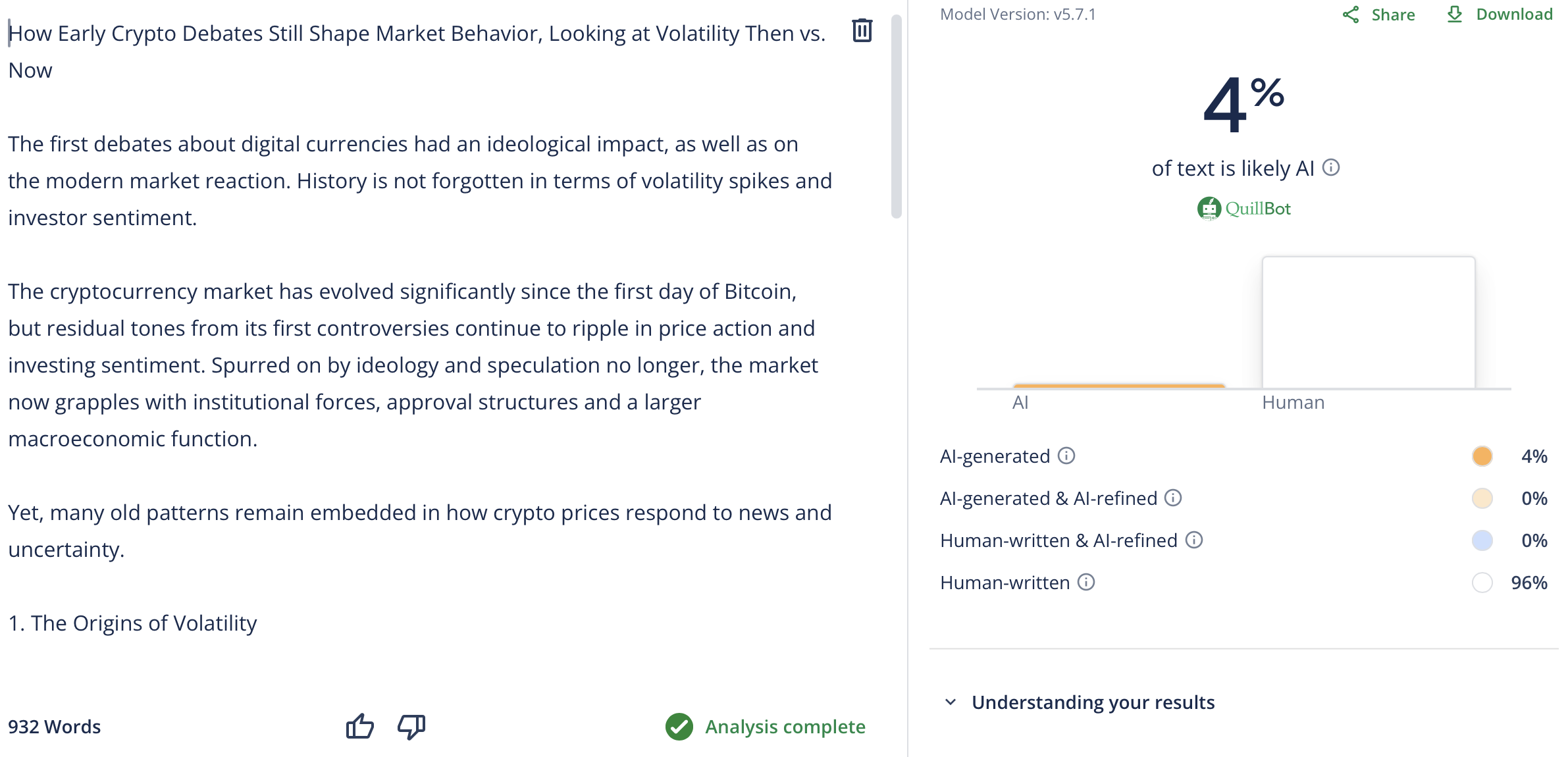Early debates over digital currencies had an ideological impact as well as modern market response. History is not forgotten in terms of volatility spikes and investor sentiment.
The cryptocurrency market has evolved significantly since Bitcoin’s first day, but the residual tones of its early controversies continue to reverberate through price action and investment sentiment. No longer driven by ideology and speculation, the market now grapples with institutional forces, approval structures, and a broader macroeconomic function. Yet many old models remain entrenched in how cryptocurrency prices respond to news and uncertainty.
1. The origins of volatility
Early crypto discussions were characterized by two opposing visions: digital gold and a decentralized payments network. This ideological divide fueled speculation and price volatility, with dealers reacting angrily to reports that their view would prevail.
The first price fluctuations of Bitcoin were spectacular. In 2013, the currency rose more than 5,000% before collapsing nearly 80%. Although shocking at the time, such volatility created a culture of rapid boom-and-bust cycles that persists today.
According to Binance Research, the total crypto market cap has seen periods where it lost over $300 billion in a single week during major corrections. It is based on the exaggerated reactions that so often follow a change in feeling or regulatory changes that give rise to the habit.
As Binance co-founder Yi He explains: “Crypto is not only the future of finance, it is already reshaping the system, one day at a time. » This constant reshaping continues to influence how investors interpret market signals, often amplifying volatility in ways that echo the early days of digital assets.
2. Institutional forces redefining the landscape
While retailer sentiment once propelled price action, institutionalization now more firmly determines market action. Statistics from virtual currency exchange Binance reveal that institutional ownership of Bitcoin now stands at 19.8%, up from just 0.9% in 2014, a widespread change in market configuration.
This institutional presence has tempered volatility but has not eliminated it. Large players often rebalance their portfolios based on macroeconomic signals, creating new patterns of rapid movements. For example:
- Seasonal Trends: Bitcoin volatility varies each year and is influenced by business cycles, halving anniversaries, and macroeconomic events.
- Macro Sensitivity: Interest rate decisions and regulatory news now trigger significant movements.
- Liquidity changes: Institutional flows can amplify rallies or deepen corrections.
“While volatility traders may see continued calm next month,” Binance analysts note, “October is also known to reverse September’s weakness.” Increased predictability reflects a maturing market, but is linked to early cycles of volatility. This ongoing fascination highlights how core narratives about scarcity and digital gold influence even the highest levels of behavior.
3. Cycles that refuse to die
Crypto, even with maturation, adheres to the cycles that early adopters are accustomed to. One of the key elements is the four-year cycle, which is rooted in Bitcoin’s halving cycles.
This cycle generally includes four phases:
- Accumulation: low volatility, slow price growth.
- Bull run: rapid appreciation as demand increases.
- Distribution: prices peak, volatility peaks.
- Bear market: Corrections test long-term conviction.
“The story suggests optimism,” the Binance commentary states. “Bitcoin has posted gains in 9 of the last 11 Octobers.” Such consistency shows how deeply ingrained these early cycles are in the market’s DNA and how traders react according to patterns established over a decade ago.
4. Regulatory developments and market behavior
Previous debates have also helped define how regulation affects market sentiment. Initial skepticism about official oversight has been replaced by a belief that transparency can build trust and entry.
Nowadays, acts like the CFTC test of tokenized collateral predict a trend of bringing crypto closer to traditional financial networks. This transition often requires volatility, but the response becomes more measured and less panicked than a strategic overhaul.
Regulatory clarity has also become a bullish indicator for institutional investors and confirmation for retailers that crypto has long-term legitimacy. However, the political optics are a strong presence of the space launcher’s libertarian ideologies.
Catherine Chen, Head of VIP and Institutional at Binance, puts it succinctly: “The regulatory architecture is gradually aligning with the operational realities of digital asset markets, making long-term institutional adoption more viable. » This alignment reflects the evolution of the market and the extent to which these early ideological struggles still shape reactions today.
5. Old lessons, new realities
The debates that once defined cryptocurrency, freedom versus regulation, store of value versus payment network, are no longer philosophical footnotes. They are integrated into market behavior.
Although crypto has a new period of integration with traditional finance, the arguments that started it all still have their say:
- Market psychology: traders are still overreacting to speeches made ten years ago.
- Volatility: Early patterns of speculation are reflected in today’s price movements.
- Adoption: Institutional participation reflects trade-offs between ideology and practicality.
As a Binance analyst said: “The traditional four-year market cycle is nearing the end of the uptrend, but this time may differ. » This difference lies in the path traveled by the market and in the part of its past that it still carries.
Crypto’s Continuing Legacy
The cryptocurrency market may be more mature, liquid and institutional than ever, but its behavior remains deeply shaped by the arguments that fueled its rise. Understanding these early debates is not only historical futility; This is the key to understanding why cryptocurrency prices continue to move the way they do.
From ideological origins to institutional realities, the past is not behind crypto. It is truly embedded in its future, influencing everything from investor psychology to long-term cycles, and guiding how the next chapter of digital finance unfolds.





